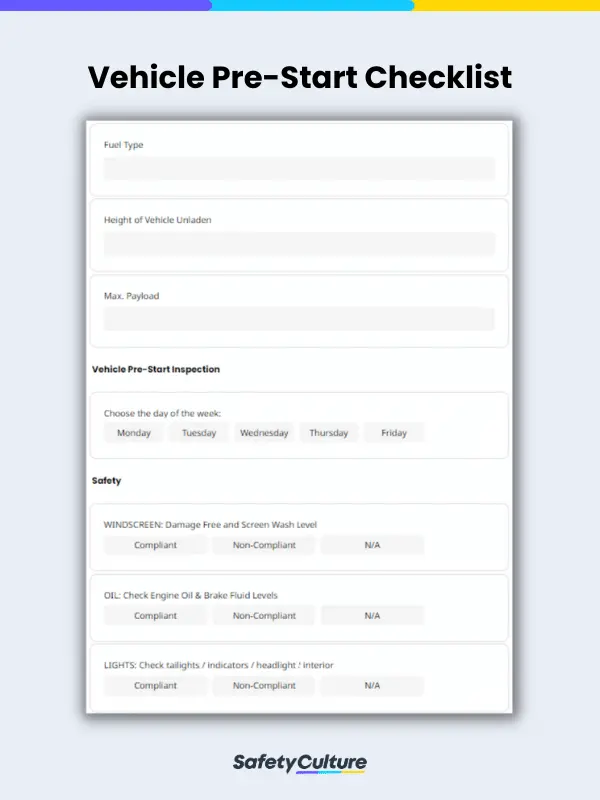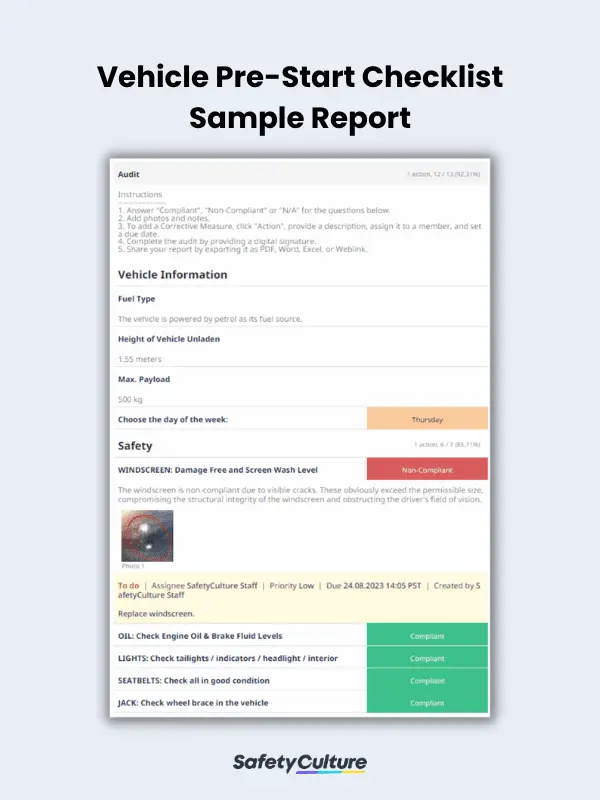What is a Vehicle Pre Start Checklist?
A vehicle pre-start checklist is a tool that lists tasks and inspections needed to be performed to assess and document the condition of a vehicle before it’s used. It helps drivers, operators, and supervisors ensure that the vehicle is in a safe and operational order, minimizing the risk of accidents, breakdowns, and other issues while on the road.
The checklist should be completed daily or before each trip or use of the vehicle. It’s considered a preventive measure aimed at identifying potential problems or safety concerns before they become more significant while driving.
Benefits of Using a Checklist for Vehicle Pre Start Inspections
A vehicle pre-start checklist is a key component of responsible vehicle operation. It doesn’t only help ensure the safety of the driver and passengers but also contributes to the overall maintenance and reliability of the vehicle. Regularly conducting these checks before each trip can prevent potential problems and promote a proactive approach to vehicle care.
With the help of a checklist, vehicle pre-start inspections can be beneficial in the following ways:
- Preventing financial losses – helps identify minor issues before they turn into major problems that are expensive to fix and cause unexpected downtime
- Uncovering defects – uncovers defects that might cause damage to the equipment if it’s started
- Legal and regulatory compliance – ensures compliance with regulatory requirements and organizational policies
- Preventive maintenance – encourages drivers to stay on top of maintenance tasks, ensuring that vehicles operate optimally and are less likely to develop unexpected issues
- Eco-friendly driving – ensures that components like air filters, tire pressure, and engine systems are in good condition, contributing to eco-friendly driving
- Consistency and accountability – provides a consistent and structured approach to vehicle inspections, reducing the chances of overlooking important aspects
- Recordkeeping – lets you maintain a record of your pre-start inspections for tracking maintenance history, identifying recurring issues, and demonstrating compliance if required
What to Include in a Vehicle Pre Start Checklist
While checklists can be unique to cater to various vehicle types, the following sections and elements must be included in a general vehicle pre-start checklist to cover a comprehensive range of aspects:
- Vehicle Information
- Safety Checks
- Vehicle Equipment
- External Bodywork
- Cleaning
- Fuel
It’s also recommended to include a title page where you can record the vehicle’s make and model and the site and location of the pre-start inspection being carried out. Lastly, have a completion page where the driver or operator can put their signature.
Guide to Creating a Vehicle Pre Start Checklist
To help you ensure an effective checklist that you can standardize and implement in your organization’s pre-start checks, here’s a quick step-by-step guide you can follow:
- Determine the specific purpose of the checklist depending on the type of vehicle and its intended use. Alternatively, you can create a general checklist and include a multiple-choice dropdown or text field to allow users to indicate unique vehicle information.
- Brainstorm all the critical aspects of your vehicle that need regular inspection. Seek feedback from respective teams and employees to help enrich the checklist with the necessary fields and sections.
- Consult your vehicle’s owner’s manual or manufacturer guidelines for recommended inspection points. These guidelines can help you identify specific items that need attention.
- Depending on your geographic location, you might need to include checks for weather-related elements like snow chains, antifreeze, or cooling system checks.
- Place safety-related items at the top of the list to ensure they receive immediate attention.
- Include specific instructions for each item to make it easier for all users to understand and perform the inspection.
- Make sure to leave room for users to write notes or comments about any issues they observe.
- As technology evolves and vehicle models change, update the checklist to stay relevant and effective.
How to Conduct Vehicle Pre Start Inspections Using a Checklist
Vehicle pre-start checks utilize a systematic approach to ensure that all key aspects are thoroughly checked before drivers hit the road. To effectively perform these inspections, here are some steps to take using a vehicle pre-start checklist:
- Familiarize yourself with the checklist and understand the items that need to be inspected.
- Before using the vehicle, go through each item on the checklist and inspect the corresponding component. Answer each question on the checklist as “Compliant,” “Non-Compliant,” or “N/A” based on the condition of the component or equipment.
- If any issues or non-compliant items are identified during the inspection, make sure to note them and assign corrective actions such as repairs and maintenance for prompt resolution.
- If possible, attach media files to capture visual evidence or add notes to provide additional details about specific items for further documentation.
- Once you have completed the inspection, review the checklist to ensure all items have been addressed. If required, have a supervisor or manager review the checklist as well.
- You can then export the checklist as a PDF or share it digitally for recordkeeping purposes.
FAQs About Vehicle Pre Start Checklists
Here are some things you should inspect in your car on a daily basis:
- Fluid levels (engine oil, engine coolant, brake fluid, power steering fluid, and windshield washer fluid)
- Fuel level
- Tires (tire pressure, signs of wear and tear, etc.)
- Lights (headlights, taillights, brake lights, and turn signals)
- Wipers
- Seatbelts
- Jack and wheel brace
- Fire extinguisher and first aid kit
In some regions and industries, especially for commercial vehicles or certain professions (such as trucking), there may be regulations or guidelines that mandate the use of pre-start checklists to ensure safety and compliance. However, for personal vehicles, the use of a pre-start checklist is generally not a legal requirement.
That said, even if not legally mandated, using a pre-start checklist is a responsible practice that can help you ensure the safety and reliability of your vehicle.
Yes, mobile apps can be used to create, customize, and use vehicle pre-start checklists. In fact, using a mobile app offers more benefits over traditional paper checklists, such as the following:
- Convenience
- Customization
- Accuracy
- Photos and Notes
- Time Stamping
- Recordkeeping
- Accessibility
- Sustainability
- Alerts and Reminders




